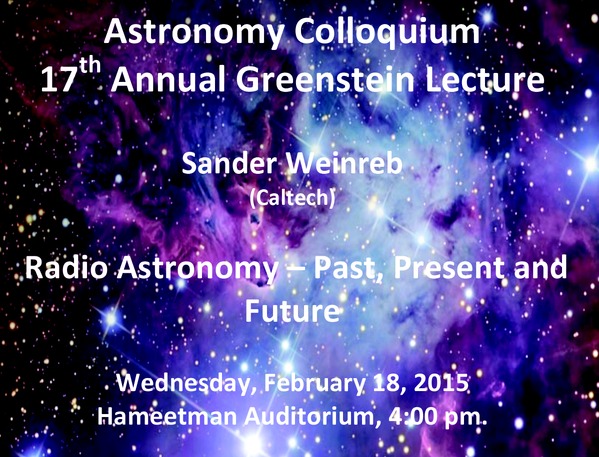
by
Sander Weinreb (Caltech and JPL)
Dr. Weinreb received his PhD in electrical engineering from the Massachusetts Institute of Technology in 1963. While still a graduate student at MIT, he developed the world's first digital autocorrelation spectrometer which he used to place a new upper limit to the Galactic deuterium to hydrogen ratio, and with Al Barrett, Lit Meeks, and J. C. Henry, made the first radio observation of an interstellar molecule: the OH ion. His autocorrelation spectrometer technique is now in use at virtually every major radio observatory throughout the world and has been crucial to the subsequent explosive growth of interstellar molecular spectroscopy. In 1965, he joined NRAO, where he became Head of the Electronics Division and later Assistant Director. During his 23 years at NRAO, he pioneered the use of low noise cryogenically cooled solid state amplifiers in radio astronomy. He was the architect for the electronic systems design for the NRAO Very Large Array in New Mexico and led the group which developed the novel front ends and the data transmission, acquisition, and monitor and control systems for the VLA. Subsequently Sandy worked at first at Lockheed Martin Laboratories and then at the University of Massachusetts where he developed MMIC amplifiers and other millimeter wave devices. Currently he is a Senior Faculty Associate at Caltech and Senior Principal Scientist at JPL, and is involved in a broad range of research, ranging from low noise amplifiers, electronics for the OVRO LWA, novel wide-band feeds and low-cost dish designs. Among his many awards are the 2008 Grote Reber Medal and the 2011 Karl Jansky Award.
Jesse was a great fan of radio astronomy: his first paper on the subject (Whipple and Greenstein 1937) was written while he was still a PhD student: a demonstration that thermal emission could not explain the 20~MHz radio emission from Sagittarius discovered by Karl Jansky in 1933-35. Beginning in 1956, Jesse pressured Caltech to get into radio astronomy, and helped organize Caltech's Owens Valley Radio Observatory, which began operation in 1958 under John Bolton's leadership. Accurate radio positions for "radio stars" led Jesse and Maarten Schmidt to obtain optical spectra of these, showing mysterious lines. Schmidt recognized that these were redshifted hydrogen lines in the first quasar, 3C273, and Jesse and Maarten Schmidt, in their landmark 1964 paper, identified the lines of the second quasar, 3C48, and presented evidence that the redshift was cosmological, and the source of energy non-nuclear. From 1965, Jesse became fascinated by white dwarfs, and in 60 papers over 20 years, he developed their spectral classification system and temperature scale, and made the fundamental studies of their proper motions, magnetic fields, element diffusion, cooling and rotation rates.
His theoretical work on dust scattering is memorialized in the Henyey-Greenstein phase function, and his theoretical work on the mechanism of dust alignment and its polarization of optical light by the Davis-Greenstein mechanism.
Jesse entered Harvard at the age of 15 and received his AB in astronomy in 1929. After a successful period rescuing the family real-estate business during the Great Depression, he was in 1934 encouraged by I.I. Rabi to quit real-estate and go back to astronomy. He did so, and earned his PhD in 1937, and then moved to Yerkes Observatory, first as a postdoc, and subsequently as instructor. During World War II, he and Henyey designed periscopes, anti-tank telescopes and fast cameras for military applications. In 1946 he became associate professor at the University of Chicago, and in 1948 was lured to Caltech to found its new astronomy department.
His many honors include the AAS Russell Lectureship, the NASA Distinguished Public Service Medal, and the Gold Medal of the Royal Astronomical Society. He chaired the second Decadal Review of Astronomy, which recommended construction of the VLA, the IRTF and the IRAS infrared satellite, the Einstein X-ray satellite, the development of CCDs, and IUE and the Hubble Space Telescope.